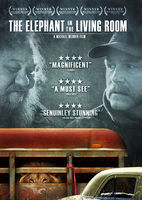
The Elephant in the Living Room (2010, dir. Michael Webber)
As The Elephant in the Living Room rolls towards a conclusion Webber appropriates a pair of Brumfield’s home videos to give a raw and powerful insight into a personal tragedy.[1] These juxtaposed excerpts represent the film’s climax and epitomise both the intense emotional relationship between Brumfield and Lambert as well as the negative consequences of keeping such an unorthodox pet. The first section of footage starts with an artificial flicker and a viewfinder (complete with crosshair) is superimposed over the shot. The corner of the frame is emblazoned with the words ‘Home Video’, rendered in a font that resembles early, tacky WordArt. The footage is obviously personal but preconceived; Brumfield is no Timothy Treadwell yet he light-heartedly attempts to prompt his lion, Lambert, into roaring for the camera. His efforts fail and the shot fades to black.
The tawdry additions seem out of keeping with the film’s concerning subject matter. Webber’s effects con the viewer into thinking all is well and Lambert momentarily slips back into place as the eponymous elephant in the Ohio backyard. Then the sound of Lambert rolls in ominously over the black screen and the natural birdsong background is augmented with minimalist music in a minor key. The viewer is initially left to guess at the tragedy that reduces the lion’s initial roar to a fit of wheezing. The ten black and unknowing seconds become two unknowing minutes as Brumfield desperately tries to figure out what is wrong with his pet. The footage is as amateurish as the first segment but reactionary darting movements and desperate conversation create juxtaposition with the calm, conventional ‘home video’ that comes before.
The chain-link obstruction that dominates the frame is perhaps the ultimate symbol of captivity. As Webber’s superimposed explanation informs us it is malfunctioning electrified cage that has killed the cat. The irony of death by defensive structure sums up the bungled nature of Brumfield’s amateur zoo keeping. At this point Safety Officer Tim Harrison’s assertions that Brumfield is at best irresponsible and at worst insane seem undeniable. Yet as Webber’s further fading frames strip away the fence the viewer is confronted with Brumfield sobbing and stroking Lambert’s mane. The camera, although a discarded voyeur, captures and frames the shot perfectly. The soaking, muddy, stroking hands are accompanied by Brumfield’s incomprehensible lamentations.
Brumfield’s love for his lion, however misplaced, is equally hard to deny. Brumfield is bestialized (in the most flattering sense) by his lion-like features and lion-like pride. The subsequent reduction of both of these ‘lions’ to such a pitiful state is a poignant and, due to the use of home footage, particularly personal tragedy. Brumfield’s love is sincere but his self-indulgence has blinded him to the symbiotic relationship he has created. Is this self-indulgent intention is common amongst other pet owners? Probably. Ultimately Lambert is a lion not a cat and however much good Brumfield takes from their relationship the risks to the animal and the public are unjustifiable. Lambert’s death is unquestionably a damning indictment against keeping such pets but Brumfield’s reaction offers a glimpse of mitigation and an insight into the genuine confusion that drives such unconventional companionship.
Filmography:
Webber, M. (dir.), The Elephant in the Living Room, NightFly Entertainment, 2010.